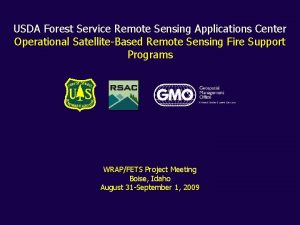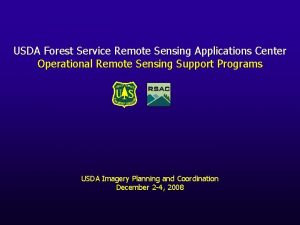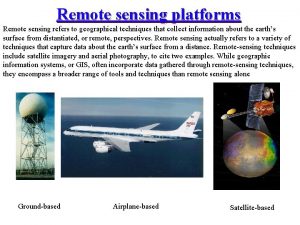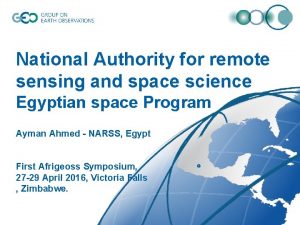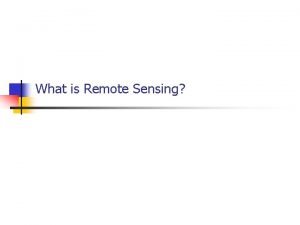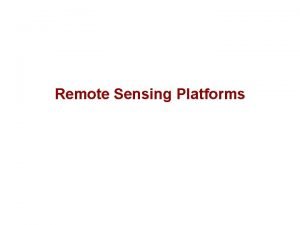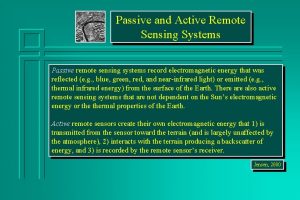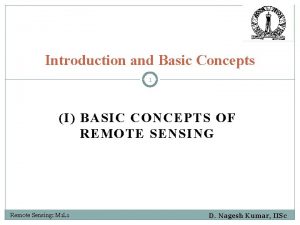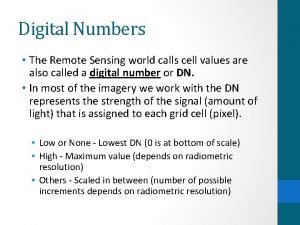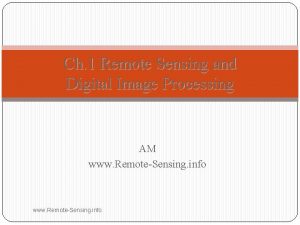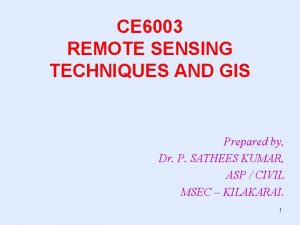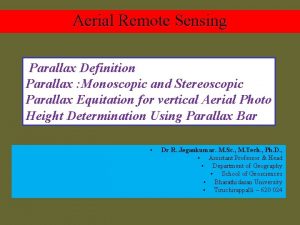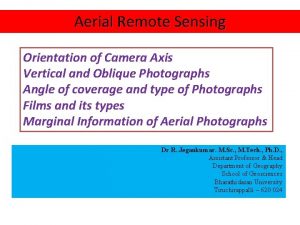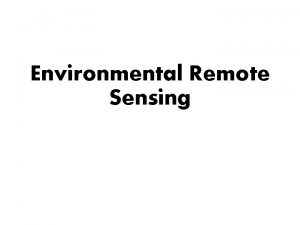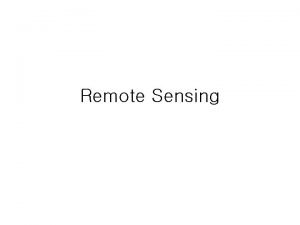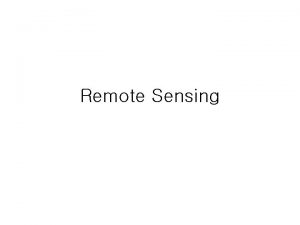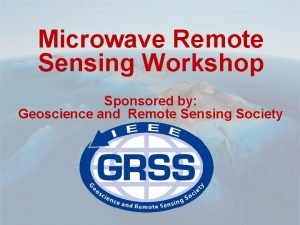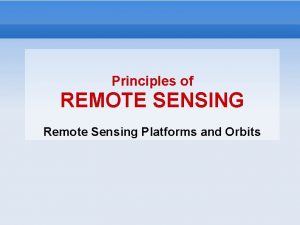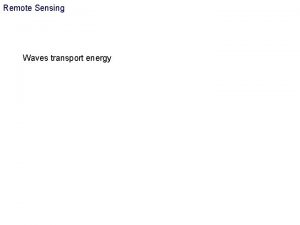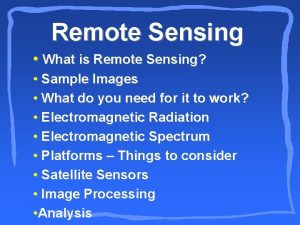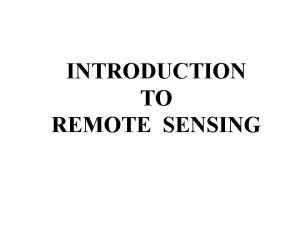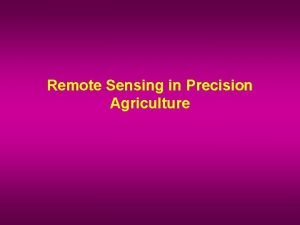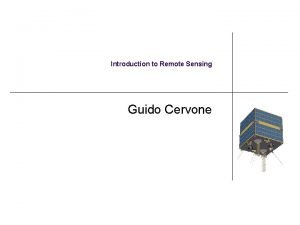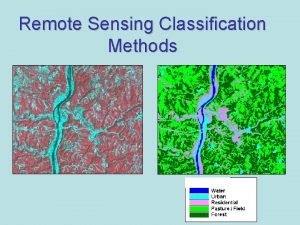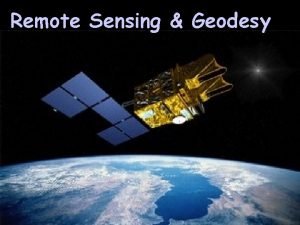Center for Remote Sensing and Computational Ecology Integrating














- Slides: 14

Center for Remote Sensing and Computational Ecology Integrating Bioluminescence into Nowcast/Forecast Systems W. Paul Bissett, Oscar M. Schofield and Mark A. Moline ONR Bioluminescence Workshop San Diego, CA February 28, 2000

Issues • How do we couple observational nowcast/forecast systems with bioluminescence sensors to yield: – 1) a framework for when and where to deploy detection systems? – 2) detection avoidance maps? ONR Bioluminescence Workshop San Diego, CA February 28, 2000

IOPs, AOPs, and Ocean Color Optically-Deep Optically-Shallow Whitecaps Micro-bubbles Shallow Ocean Floor Suspended Sediments Phytoplankton 1/Kd ONR Bioluminescence Workshop San Diego, CA Benthic Plants CDOM-Rich Water February 28, 2000

Hy. CODE Application Scenarios Autonomous Sampling Networks - Environmental characterization - Communication ONR Bioluminescence Workshop San Diego, CA Remote sensing products Sensor performance Environment Prediction Situ Da ta Ima gery In Satellite ocean sensors: - NEMO - Sea. Wi. FS - AVHRR Aircraft sensors: - Hyperspectral - Lidar Expendable sensors Mission Planning Sampling Strategy Underwater imaging systems: - Mine ID - Benthic characterization February 28, 2000

Light Propagation in Eco. Sim For each depth interval light attenuation c(l, t) = a(l, t) + b(l, t) absorption a(l, t) = awater(l) + aphyto(l) + a. CDOM(l) + ased(l) scattering b(l, t) = bwater(l) + bphyto(l) + b. CDOM(l) + bsed(l) backscattering bb(l, t) = bb, water(l) + bb, phyto(l) + bb, CDOM(l) + bb, sed(l) geometric structure of light md(l) = fxn[b(l, t), c (l , t), m 0(l)] diffuse light attenuation Kd(l) = [a(l, t) + bb(l , t)]/md(l)] water leaving radiance to a satellite Lu(l) = fxn[a(l, t), b(l , t), bb(l , t), Ed(l, t), md(l), mu(l)] ONR Bioluminescence Workshop San Diego, CA February 28, 2000

Eco. Sim 2. 0 Model Formulation Air/Sea CO 2 Dust Iron CO 2 Physical Mixing and Advection NH 4 NO 3 Relict DOM PO 4 Pelagic Diatoms G. breve Light N 2 Si. O 4 Dinoflagellate Trichodesmium Synechococcus Coccolithophores Excreted DOM Lysed DOM Viruses Copepod Ciliates Hetero. Flagellet Bacteria Sediment Detritus ONR Bioluminescence Workshop San Diego, CA Predator Closure February 28, 2000 Benthic Flora

IOPs, AOPs, and Ocean Color Optically-Deep Optically-Shallow Whitecaps Micro-bubbles Shallow Ocean Floor Suspended Sediments Phytoplankton 1/Kd ONR Bioluminescence Workshop San Diego, CA Benthic Plants CDOM-Rich Water February 28, 2000

Eco. Sim 2. 0 Model Formulation Air/Sea CO 2 Dust Iron CO 2 Physical Mixing and Advection NH 4 NO 3 Relict DOM PO 4 Pelagic Diatoms G. breve Light N 2 Si. O 4 Dinoflagellate Trichodesmium Synechococcus Coccolithophores Benthic Flora Excreted DOM Lysed DOM Viruses Copepod Ciliates Hetero. Flagellet Bacteria Sediment Detritus ONR Bioluminescence Workshop San Diego, CA Predator Closure February 28, 2000 Ctenpphores

Bioluminescent Light Propagation in Eco. Sim For each depth interval light attenuation c(l, t) = a(l, t) + b(l, t) absorption a(l, t) = awater(l) + aphyto(l) + a. CDOM(l) + ased(l) scattering b(l, t) = bwater(l) + bphyto(l) + b. CDOM(l) + bsed(l) backscattering bb(l, t) = bb, water(l) + bb, phyto(l) + bb, CDOM(l) + bb, sed(l) geometric structure of light md(l) = fxn[b(l, t), c (l , t), m 0(l)] diffuse light attenuation Kd(l) = [a(l, t) + bb(l , t)]/md(l)] water leaving radiance to a satellite Lu(l) = fxn[a(l, t), b(l , t), bb(l , t), Ed(l, t), md(l), mu(l)] ONR Bioluminescence Workshop San Diego, CA February 28, 2000

IOPs from LEO-15 - July 16, 1999 ONR Bioluminescence Workshop San Diego, CA February 28, 2000

Kd(490) and Predicted Surface Bioluminescence Yield 10 -11 W m-2 sr-1 is approximately 2. 5 x 107 photons m-2 sr-1 10 -5 W m-2 sr-1 is approximately 2. 5 x 1013 photons m-2 sr-1 ONR Bioluminescence Workshop San Diego, CA February 28, 2000

Predicted Surface Bioluminescence Yield from 10 m event 10 -11 ONR Bioluminescence Workshop San Diego, CA W m-2 sr-1 10 -7 February 28, 2000

Predicted Surface Bioluminescence Yield from 10 m event 10 -11 ONR Bioluminescence Workshop San Diego, CA W m-2 sr-1 10 -7 February 28, 2000

Summary • Optical properties of the water column directly impact bioluminescence signal propagation. – Accurate knowledge of the IOPs and AOPs is required for any instrument performance modeling, as well as determining detection horizons. • Bioluminescence can be incorporated into nowcast/forecast systems currently under development. • Optical properties derived from current remote sensing tools can be used to estimate detection horizons for hypothesized bioluminescence event. • Remote sensing and nowcast/forecast tools may be coupled to yield probability horizons and performance prediction tools. ONR Bioluminescence Workshop San Diego, CA February 28, 2000
 Remote sensing applications center
Remote sensing applications center Remote sensing applications center
Remote sensing applications center Ifov and fov in remote sensing
Ifov and fov in remote sensing National authority for remote sensing and space sciences
National authority for remote sensing and space sciences N-rays
N-rays Remote sensing platforms
Remote sensing platforms Active remote sensing
Active remote sensing Ideal remote sensing system
Ideal remote sensing system Digital number remote sensing
Digital number remote sensing Limitations of remote sensing
Limitations of remote sensing Idealized remote sensing system
Idealized remote sensing system Gis definition ap human geography
Gis definition ap human geography Topographic map definition ap human geography
Topographic map definition ap human geography Parallax in aerial photography
Parallax in aerial photography Strip camera in remote sensing
Strip camera in remote sensing
